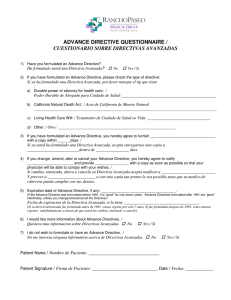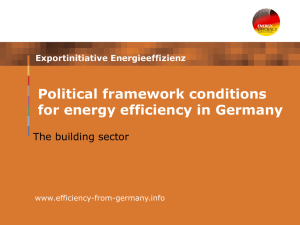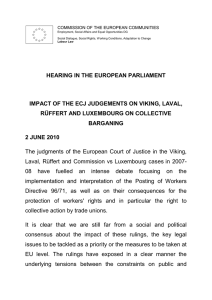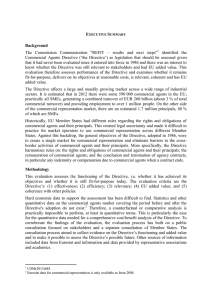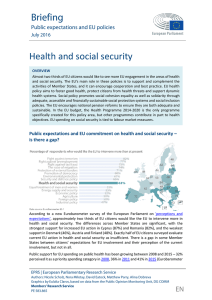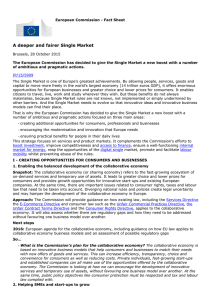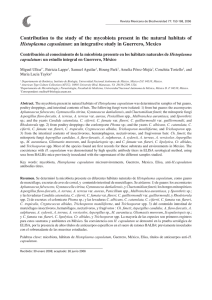Commission Implementing Decision of 12 December 2012
Anuncio
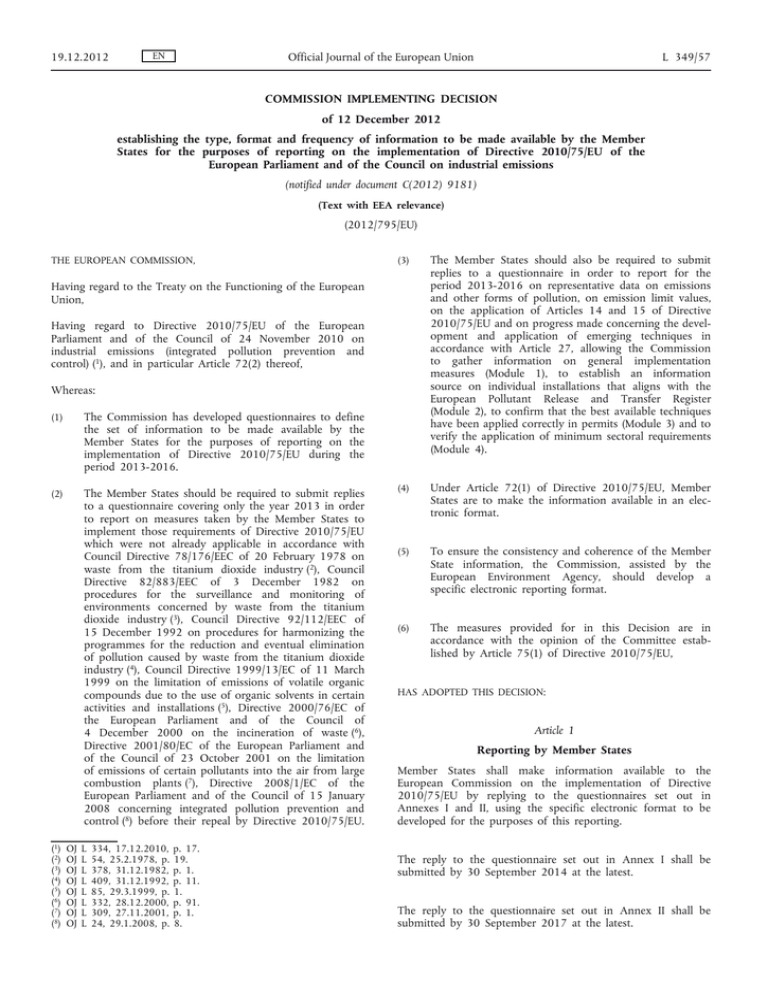
19.12.2012 EN Official Journal of the European Union L 349/57 COMMISSION IMPLEMENTING DECISION of 12 December 2012 establishing the type, format and frequency of information to be made available by the Member States for the purposes of reporting on the implementation of Directive 2010/75/EU of the European Parliament and of the Council on industrial emissions (notified under document C(2012) 9181) (Text with EEA relevance) (2012/795/EU) THE EUROPEAN COMMISSION, (3) The Member States should also be required to submit replies to a questionnaire in order to report for the period 2013-2016 on representative data on emissions and other forms of pollution, on emission limit values, on the application of Articles 14 and 15 of Directive 2010/75/EU and on progress made concerning the devel­ opment and application of emerging techniques in accordance with Article 27, allowing the Commission to gather information on general implementation measures (Module 1), to establish an information source on individual installations that aligns with the European Pollutant Release and Transfer Register (Module 2), to confirm that the best available techniques have been applied correctly in permits (Module 3) and to verify the application of minimum sectoral requirements (Module 4). (4) Under Article 72(1) of Directive 2010/75/EU, Member States are to make the information available in an elec­ tronic format. (5) To ensure the consistency and coherence of the Member State information, the Commission, assisted by the European Environment Agency, should develop a specific electronic reporting format. (6) The measures provided for in this Decision are in accordance with the opinion of the Committee estab­ lished by Article 75(1) of Directive 2010/75/EU, Having regard to the Treaty on the Functioning of the European Union, Having regard to Directive 2010/75/EU of the European Parliament and of the Council of 24 November 2010 on industrial emissions (integrated pollution prevention and control) (1), and in particular Article 72(2) thereof, Whereas: (1) The Commission has developed questionnaires to define the set of information to be made available by the Member States for the purposes of reporting on the implementation of Directive 2010/75/EU during the period 2013-2016. (2) The Member States should be required to submit replies to a questionnaire covering only the year 2013 in order to report on measures taken by the Member States to implement those requirements of Directive 2010/75/EU which were not already applicable in accordance with Council Directive 78/176/EEC of 20 February 1978 on waste from the titanium dioxide industry (2), Council Directive 82/883/EEC of 3 December 1982 on procedures for the surveillance and monitoring of environments concerned by waste from the titanium dioxide industry (3), Council Directive 92/112/EEC of 15 December 1992 on procedures for harmonizing the programmes for the reduction and eventual elimination of pollution caused by waste from the titanium dioxide industry (4), Council Directive 1999/13/EC of 11 March 1999 on the limitation of emissions of volatile organic compounds due to the use of organic solvents in certain activities and installations (5), Directive 2000/76/EC of the European Parliament and of the Council of 4 December 2000 on the incineration of waste (6), Directive 2001/80/EC of the European Parliament and of the Council of 23 October 2001 on the limitation of emissions of certain pollutants into the air from large combustion plants (7), Directive 2008/1/EC of the European Parliament and of the Council of 15 January 2008 concerning integrated pollution prevention and control (8) before their repeal by Directive 2010/75/EU. (1 ) (2 ) (3 ) (4 ) (5 ) (6 ) (7 ) (8 ) OJ OJ OJ OJ OJ OJ OJ OJ L L L L L L L L 334, 17.12.2010, 54, 25.2.1978, p. 378, 31.12.1982, 409, 31.12.1992, 85, 29.3.1999, p. 332, 28.12.2000, 309, 27.11.2001, 24, 29.1.2008, p. p. 17. 19. p. 1. p. 11. 1. p. 91. p. 1. 8. HAS ADOPTED THIS DECISION: Article 1 Reporting by Member States Member States shall make information available to the European Commission on the implementation of Directive 2010/75/EU by replying to the questionnaires set out in Annexes I and II, using the specific electronic format to be developed for the purposes of this reporting. The reply to the questionnaire set out in Annex I shall be submitted by 30 September 2014 at the latest. The reply to the questionnaire set out in Annex II shall be submitted by 30 September 2017 at the latest. L 349/58 EN Official Journal of the European Union Article 2 This Decision is addressed to the Member States. Done at Brussels, 12 December 2012. For the Commission Janez POTOČNIK Member of the Commission 19.12.2012 EN 19.12.2012 Official Journal of the European Union ANNEX I Questionnaire on the implementation of Directive 2010/75/EU as referred to in the second paragraph of Article 1 General notes: (a) The replies to this questionnaire shall cover the period from 7 January 2013 to 31 December 2013. (b) Where a question seeks information on time-variable parameters, the response should indicate the situation as of 31 December 2013. (c) In the replies to the questions below, information shall only be given on the changes made by Member States in order to implement the provisions of Directive 2010/75/EU mentioned in its Article 80(1). (d) In this questionnaire, ‘Member State policy or guidance’ shall be understood as having the meaning of any existing implementation measure that is produced or applied at national, regional or local level. Should a Member State wish to include information concerning legislation that transposes Directive 2010/75/EU into national law, this would not negate the need for Member States to meet the requirements of Article 80(2) of Directive 2010/75/EU. 1. Non-compliance (Article 8) What criteria may be used to decide whether a breach of permit conditions ‘poses an immediate danger to human health or threatens to cause an immediate significant adverse effect upon the environment’? 2. Permit conditions (Article 14) Provide a summary of any Member State policy or guidance on the following issues and, if published on the internet, a link to where this can be found: 2.1. How is it ensured that BAT conclusions are the reference for setting permit conditions (Article 14(3))? 2.2. How may competent authorities set stricter permit conditions than those achievable by the use of the best available techniques (BAT) as described in BAT conclusions (Article 14(4))? 3. Emission limit values, equivalent parameters and technical measures (Article 15) Provide a summary of any Member State policy or guidance on the following issues and, if published on the internet, a link to where this can be found: 3.1. How are emission limit values set in relation to the ‘emission levels associated with the best available techniques’ set out in the BAT conclusions (Article 15(3))? 3.2. How are derogations from Article 15(3) granted (Article 15(4))? 3.3. How is the cost-benefit assessment to allow such derogations undertaken and what are considered to be ‘dis­ proportionately higher costs compared to the environmental benefits’? (Article 15(4))? 3.4. Are there any limitations on the magnitude or duration of derogations (Article 15(4))? 3.5. How are temporary derogations granted, from the requirements of Article 11(a) and (b) and from Article 15(2) and (3), for the testing and use of emerging techniques (Article 15(5))? 4. Monitoring requirements (Article 16) Provide a summary of any Member State policy or guidance on the following issues and, if published on the internet, a link to where this can be found: 4.1. How is it ensured that the BAT conclusions are the basis for defining monitoring requirements in permits (Article 16(1))? 4.2. How is the frequency of periodic monitoring for soil and groundwater determined (Article 16(2))? L 349/59 EN L 349/60 Official Journal of the European Union 4.3. How is a ‘systematic appraisal of risk of contamination’ used to justify the monitoring of soil and groundwater at less than the stipulated frequency (Article 16(2))? 5. General Binding Rules (Article 17) Where general binding rules are used for implementing Directive 2010/75/EU: 5.1. Which requirements, activities (as listed in Annex I to Directive 2010/75/EU) and pollutants do the general binding rules cover? 5.2. How do general binding rules ‘ensure an integrated approach and a high level of environmental protection equivalent to that achievable with individual permit conditions’ (Article 17(1))? 5.3. How is it ensured that general binding rules are ‘based on the BAT’ (Article 17(2))? 5.4. How are general binding rules ‘updated to take into account developments in BAT’ (Article 17(3))? 5.5. What references are made to Directive 2010/75/EU in the ‘official publication’ of general binding rules (Article 17(4))? 5.6. If the general binding rules are published on the internet, provide a link to where they can be found. 6. Developments in BAT (Article 19) 6.1. How do competent authorities follow, or are informed of, the publication of any new or updated BAT conclusions? 6.2. How do competent authorities make that information available to the public concerned? 7. Reconsideration and updating of permits (Article 21) Provide a summary of any Member State policy or guidance on the following aspects of the process for recon­ sidering and updating permit conditions and, if published on the internet, provide a link: 7.1. What information is typically requested from operators for the purposes of permit reconsideration/updating (Article 21(2))? 7.2. How is the ‘main activity’ of an installation defined and/or determined (Article 21(3))? 7.3. How is the permit reconsideration/update triggered in cases of significant pollution, operational safety, or a new/revised environmental quality standard (Article 21(5))? 8. Site closure (Article 22) 8.1. How is it decided which activities require a baseline report, especially: (a) Which activities listed in Annex I to Directive 2010/75/EU have typically been found to involve the ‘use, production or release of relevant hazardous substances’ (Article 22(2))? (b) How is regard given to the ‘possibility of soil and groundwater contamination at the site of the installation’ (Article 22(2))? (c) What information are operators required to include in baseline reports (Article 22(2))? (d) How has the Commission’s guidance on ‘the content of the baseline report’ been used in this context (Article 22(2))? 8.2. Upon the definitive cessation of activities: (a) How do operators ‘assess the state of soil and groundwater contamination’ (Article 22(3))? (b) How is it decided whether an installation has caused ‘significant pollution of soil or groundwater’ (Article 22(3))? 19.12.2012 EN 19.12.2012 Official Journal of the European Union (c) How is it decided whether any contamination of soil or groundwater ‘poses a significant risk to human health or the environment’ (Article 22(3))? (d) How is it decided what necessary ‘measures’ or ‘actions’ are required of operators (Article 22(3) and (4))? 9. Environmental inspections (Article 23) 9.1. What ‘environmental inspection plans’ have been drawn up? What do they contain? Where are they publicly available? If published on the internet, provide a link (Article 23(2))? 9.2. What ‘programmes for routine environmental inspections’ have been drawn up? What do they contain? Where are they publicly available? If published on the internet, provide a link. (Article 23(4))? 9.3. How are the environmental risks of installations ‘systematically appraised’ for the purposes of deciding the site visit frequency? Provide a summary and reference to any relevant guidance. (Article 23(4))? 9.4. Under what circumstances are ‘non-routine environmental inspections’ carried out (Article 23(5))? 9.5. What information do the site visit reports typically contain? How are these reports notified to the operator? How are they made publicly available? Are there any circumstances under which such reports have not been made publicly available, considering the provisions of Directive 2003/4/EC of the European Parliament and of the Council of 28 January 2003 on public access to environmental information and repealing Council Directive 90/313/EEC (1) (Article 23(6))? 9.6. What mechanisms exist for ensuring that operators complete the ‘necessary actions’ identified in the site visit report (Article 23(6))? 10. Access to information and public participation (Article 24) 10.1. How is the public given ‘early and effective opportunity’ to participate in decision making on the granting/updating of permit conditions, especially where derogations under Article 15(4) are proposed (Article 24(1))? 10.2. How is information made available to the public (Article 24(2) and (3))? 10.3. Is all relevant information made available on the internet (Article 24(2)(a),(b) and (f) and Article 24(3)(a))? 11. Emerging techniques (Article 27) How do Member States encourage the development and application of emerging techniques, in particular those identified in BAT reference documents (Article 27(1))? (1) OJ L 41, 14.2.2003, p. 26. L 349/61 EN L 349/62 Official Journal of the European Union 19.12.2012 ANNEX II Questionnaire on the implementation of Directive 2010/75/EU as referred to in the third paragraph of Article 1 General notes: (a) This questionnaire covers the period from 7 January 2013 to 31 December 2016. (b) Where a question seeks information on time-variable parameters, the response should indicate the situation as of 31 December 2016. MODULE 1 — IMPLEMENTATION UPDATE Module 1 note: The scope of these questions is installations covered by Chapter II of Directive 2010/75/EU. 1. Implementation – changes Have any major changes to the implementation of Directive 2010/75/EU been made since the last reporting period, compared to the information reported in response to the questionnaire for first reporting under IED? If so, provide an update by describing the changes and the reasons for them, and provide references where appropriate. 2. Implementation — difficulties Have you encountered any difficulties in applying the laws, regulations and administrative provisions adopted in accordance with Article 80(1)? If yes, describe these difficulties and the reasons for them. MODULE 2 – INFORMATION ON INDIVIDUAL INSTALLATIONS Module 2 note: Cross-references to other EU legislation are merely to identify that these interactions exist. It is not intended to map the exact interfaces between installations covered by each of those regimes. 3. Provide the following information for all installations covered by Chapter II of Directive 2010/75/EU (‘IED installations’) 3.1. General information: Field Description 3.1.1. Reference number of the IED installation Unique installation identifier for the purposes of Directive 2010/75/EU. 3.1.2. Reference number of the facility covered by Regulation (EC) No 166/2006 of the European Parliament and of the Council of 18 January 2006 concerning the estab­ lishment of a European Pollutant Release and Transfer Register and amending Council Directives 91/689/EEC and 96/61/EC (1) (optional) Where the IED installation is, fully or partly, covered by Regulation (EC) No 166/2006, provide the identifi­ cation number used for the reporting of the facility under that Regulation. 3.1.3. Reference number of the establishment covered by Directive 2012/18/EU of the European Parliament and of the Council of 4 July 2012 on the control of major-accident hazards involving dangerous substances, amending and subsequently repealing Council Directive 96/82/EC (2) (optional) Where the IED installation is, fully or partly, covered by Directive 2012/18/EU, provide the unique identifier used in the Seveso Plant Information Retrieval System (SPIRS). 3.1.4. Reference number of the installation covered by the Directive 2003/87/EC of the European Parliament and of the Council of 13 October 2003 establishing a scheme for greenhouse gas emission allowance trading within the Community and amending Council Directive 96/61/EC (3) (optional) Where the IED installation is, fully or partly, covered by Directive 2003/87/EC, provide the unique registry identifier from the EU Transaction Log. 3.1.5. Installation name In a format compatible with the field ‘Name of the facility’ used in the reporting under Regulation (EC) No 166/2006; if possible. EN 19.12.2012 Official Journal of the European Union Field L 349/63 Description 3.1.6. Activities covered by Directive 2010/75/EU All activities listed in Annex I to Directive 2010/75/EU which are operated in the installation. 3.1.7. Other relevant Chapters of Directive 2010/75/EU Indicate which of the Chapters III, IV, V and VI of Directive 2010/75/EU also apply to the installation (or part thereof). 3.2. Contact information: Description Field 3.2.1. Operator name In a format compatible with the field ‘Name of parent company’ used in the reporting under Regulation (EC) No 166/2006, if possible. 3.2.2. Installation address — street, town, postal code and country In accordance with Directive 2007/2/EC of the European Parliament and of the Council of 14 March 2007 establishing an Infrastructure for Spatial Information in the European Community (4), and in a format compatible with the field ‘Street address’, ‘Town/ village’, ‘Postal code’, ‘Country’ used in the reporting under Regulation (EC) No 166/2006, if possible. 3.2.3. Installation latitude/longitude In accordance with Directive 2007/2/EC, and in a format compatible with the field ‘Coordinates of the location’ used in the reporting under Regulation (EC) No 166/2006, if possible. 3.3. Competent authorities: Field Description 3.3.1. Competent authority for the granting of permits Name of competent authority/authorities and e-mail address(es). 3.3.2. Competent authority for inspections and enforcement Name of competent authority/authorities and e-mail address(es). 3.3.3. Total number of site visits by competent authorities (Article 23(4)) Annual total for each of the years 2013, 2014, 2015 and 2016. 3.4. Permit information: Field Description 3.4.1. A web link to active permits As required by Article 24(2). 3.4.2. Is the installation subject to derogation under Article 15(4)? Yes/No 3.4.3. Has a baseline report been prepared under Article 22? Yes/No (1) (2) (3) (4) OJ OJ OJ OJ L L L L 33, 4.2.2006, p. 1. 197, 24.7.2012, p. 1. 275, 25.10.2003, p. 32. 108, 25.4.2007, p. 1. EN L 349/64 Official Journal of the European Union MODULE 3 – SECTORAL SPOTLIGHT Module 3 notes: The scope of this module is installations where published Decisions on BAT conclusions have triggered permit recon­ sideration/updating during the reporting period, i.e. installations where the main activity is covered by: — Commission Implementing Decision of 28 February 2012 2012/134/EU establishing the best available techniques (BAT) conclusions under Directive 2010/75/EU of the European Parliament and of the Council on industrial emissions for the manufacture of glass (1); or — Commission Implementing Decision of 28 February 2012 2012/135/EU establishing the best available techniques (BAT) conclusions under Directive 2010/75/EU of the European Parliament and of the Council on industrial emissions for iron and steel production (2). 4. Permit conditions (Article 14) Have any other sources of information, apart from BAT conclusions, been used as the reference for setting permit conditions (Article 14(3))? 5. Stricter permit conditions (Articles 14(4) and 18) 5.1. Which environmental quality standards required stricter permit conditions than those achievable by the use of BAT, and what additional measures were included in the permits (Article 18)? 5.2. Provide examples of other situations where the competent authorities have, under Article 14(4), set stricter permit conditions than achievable by the use of BAT. 6. Setting permit conditions in the absence of relevant BAT conclusions (Article 14(5) and (6)) 6.1. Describe the procedure for, and examples of, setting permit conditions: (a) on the basis of a BAT not described in any of the relevant BAT conclusions (Article 14(5)); (b) on the basis of a BAT determined in consultation with the operator, because the individual BAT conclusions do not cover ‘an activity or a type of production process carried out within an installation’ or ‘do not address all the potential environmental effects of the activity or process’ (Article 14(6)). 6.2. For the above examples, identify: (a) why the information in the BAT conclusions was not applicable; (b) which supplementary information sources were used to identify BAT; (c) how the criteria listed in Annex III to Directive 2010/75/EU were given special consideration. 7. Emission limit values, equivalent parameters and technical measures (Article 15) 7.1. For permits where one or more emission limit value(s) are different to the emission levels associated with BAT in the BAT conclusions in terms of values, periods of time or reference conditions (Article 15(3)(b)): (a) describe the nature of these different emission limit values and provide examples of them; (b) provide examples, using the data summary referred to in Article 14(1)(d)(ii), showing how emission monitoring has been used to ‘ensure that emissions under normal operating conditions have not exceeded the emission levels associated with the best available techniques’ (the second subparagraph of Article 15(3)). 7.2. For all installations where an Article 15(4) derogation has been granted, indicate the: (a) emission sources benefitting from a derogation; (b) emission levels associated with BAT for which a derogation has been granted; (c) actual emission limit values; (d) transitional period(s) granted to comply with Article 15(3), if any; (e) website(s) containing information on the application of Article 15(4) derogations (Article 24(2)(f)). 7.3. Have temporary derogations been granted for the testing and use of emerging techniques (Article 15(5)). (1) OJ L 70, 8.3.2012, p. 1. (2) OJ L 70, 8.3.2012, p. 63. 19.12.2012 EN 19.12.2012 Official Journal of the European Union 8. Monitoring (Article 16) 8.1. In general terms, what monitoring frequencies have been set in permits for air emissions, water emissions, soil/groundwater emissions and other relevant process parameters? 8.2. How have BAT conclusions been used to determine these frequencies? 9. Reconsideration and updating of permit conditions (Article 21) For all permit reconsiderations that were not completed by 8 March 2016, identify: (a) the installation names and permit reference numbers; (b) the reasons for not having completed the reconsideration; (c) the date by which the reconsideration will be completed. 10. Other Do you have feedback on any practical problems you encountered in using the BAT conclusions for the two sectors in the scope of this Module 3? MODULE 4 – ‘MINIMUM’ REQUIREMENTS 11. Waste incineration and co-incineration: For plants covered by Chapter IV of Directive 2010/75/EU: 11.1. Identify the plants for which competent authorities have authorised conditions under Article 51(1), (2) or (3) as well as the actual conditions authorised and the results of verifications made in this respect–(Article 51(4)). 11.2. For each waste incineration plant and waste co-incineration plant with a capacity of 2 tonnes or more per hour, provide: (a) information on the functioning and monitoring of the plant; (b) an account of the running of the incineration or co-incineration process (indicating the operational hours, number and cumulative duration of break-downs, if available); (c) the level of emissions into air and water, in comparison with the emission limit values; (d) a description of how this information has been made available to the public, including a link to any relevant websites created for this purpose (Article 55(2)). 12. Solvent Emissions For installations covered by Chapter V of Directive 2010/75/EU: 12.1. Where Member States have opted to apply a reduction scheme (as described in Annex VII, Part 5) instead of emission limit values, what progress has been made in achieving an equivalent emission reduction (Article 59(1)(b))? 12.2. Identify the plants for which derogations were granted in accordance with Article 59(2) or Article 59(3), as well as the justification for granting such derogations. L 349/65

